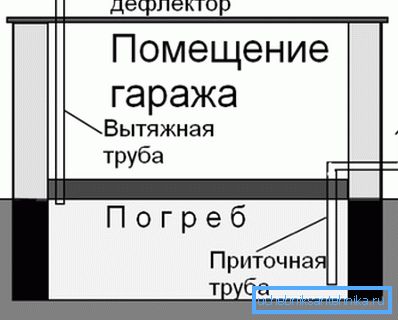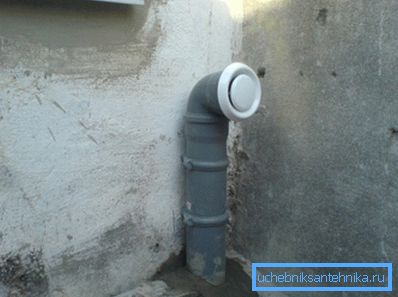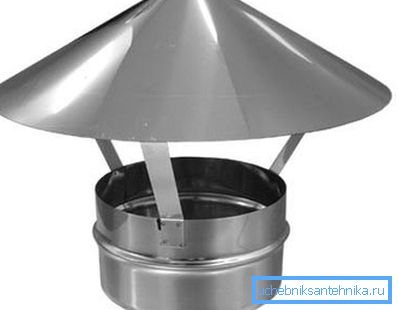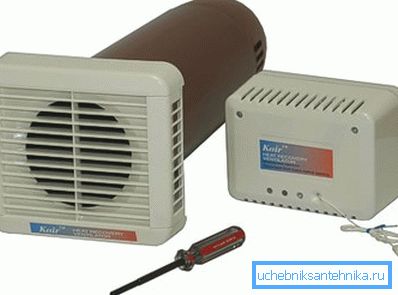Cellar ventilation in the garage: the features of
In this article we will talk about how the ventilation of the cellar in the garage with its own hands is made, what it is and how it works. The issue of maintaining the optimum level of humidity is relevant both for a residential house and for outbuildings.

However, most importantly, the need to maintain the optimum level of humidity is felt precisely in the garage hole, since there is no provision for windows and air vents.

The instruction of the correct device of the cellar implies the observance of a number of conditions, including:
- Relative humidity not more than 90%.
- Constantly low temperature, which is provided by the location of the cellar below the surface of the earth.
- The absence of bright light, which allows for a long time to store various supplies without compromising their consumer properties.
Ensuring effective ventilation within a single room allows you to maintain an optimum level of humidity, which, in turn, ensures that the strength of the plaster layer of walls and floors is maintained, and also prevents the appearance of mold.
So, we found out that effective ventilation of basements and cellars is needed no less than airing living spaces. It remains to consider the features of the choice of design and manufacture of more or less effective control systems for moisture content in the air.
Natural ventilation system
The simplest ventilation in the basement of a garage consists of two ducts:
- one duct provides fresh air from outside;
- The second duct is responsible for removing warm air to the outside.
This kind of control system of moisture content of air is considered natural, since the circulation is carried out due to the temperature difference inside and outside the object. With proper system design, intensive air circulation is ensured, regardless of the climatic conditions outside the building.
The choice of materials for the device ducts

In order for the ventilation in the cellar under the garage for a long time to be characterized by optimal performance, it is necessary to select the correct parameters of pipes for air ducts and correctly position these structural elements relative to each other.
The optimal material for the device duct is asbestos, polyethylene or galvanized steel pipe, the price of which is low. Products from the listed materials are practically not oxidized due to exposure to excessive humidity, and therefore the ventilation of the garage basement that you assembled for a long time will not require repair.
The important point is the calculation of pipe sizes. There are many calculation algorithms, but on the other hand, you can use data tested in real conditions. According to these data, about 26 square centimeters of duct area will be required per 1 square meter of cellar area.
As a rule, most of the cellars under the garage have similar sizes, so you can’t go wrong if you use pipes with a diameter of 100 mm.
Installation Features

Once we have decided on the type of materials used, consider how to make ventilation in the basement of the garage.
- The inlet pipe is installed in such a way that outside air gets inside the room.
To ensure the efficiency of the system as a whole, the intake pipe must be placed opposite the exhaust duct. On average, the supply air duct is located half a meter from the floor level, and passing through the floor, with the external end rises approximately 70 cm above the ground level.
- The exhaust pipe is installed opposite the intake duct and ensures removal of moist, warmer air from the room to the outside.. The pipe is located under the ceiling of the basement, and then goes out and about half a meter towers above the roof of the garage.

Taking into account that this air duct serves to remove humid air to the outside, care must be taken to ensure that condensate does not enter the basement. To do this, it is enough to arrange the opening of the pipe in the basement slightly higher than the angle of the knee bred from the outside. Thus, a natural slope appears, and water will accumulate in the knee.
To bring the water out, in the fold it is necessary to make a hole through which the precipitated condensate will flow. In addition, to reduce the likelihood of condensation will allow high-quality insulation of the duct throughout the outer section. For insulation, you can use mounting foam, jute tape or thin layers of mineral wool.
Important: It is necessary to take timely care to protect the cellar from the penetration of rodents and insects from the outside. To do this, you need to cover the outlet holes with fine meshed barrier nets.
Ways to check the effectiveness of ventilation
Now that we know how to make ventilation in the cellar of the garage, we need to find out how efficiently it works. If the system is built incorrectly, the performance will be insufficient and dampness and mold will appear in the room.
In fact, it is easy to check the operation of ventilation, and this can be done as follows. We bring the flame of a candle or a lighter to the exhaust orifice and look in what direction the tongue will deviate.
If the flame is directed towards the exhaust port, then everything is fine and the system is functioning. If the flame is motionless, then there is a significant problem and one of the air ducts will have to be redone.
Tip: Most often, the problem can be corrected by increasing the location of the external opening of the exhaust pipe.
Forced exhaust

As you already understood, the natural ventilation system in the basement of the garage works by thrust in the exhaust pipe, which is created by the difference in temperature and the difference in height. In those cases, if you can’t install pipes with a difference in levels, you can use forced ventilation.
The principle of the system is based on the use of electric drives with blades on one of the ducts or on both. The supply and discharge of air in this case is provided by the direction of rotation of the fan blades.
Conclusion
Now that we know how to properly make the ventilation in the basement of the garage, you can purchase the necessary materials and complete the planned work. More useful information you can find by watching the video in this article.